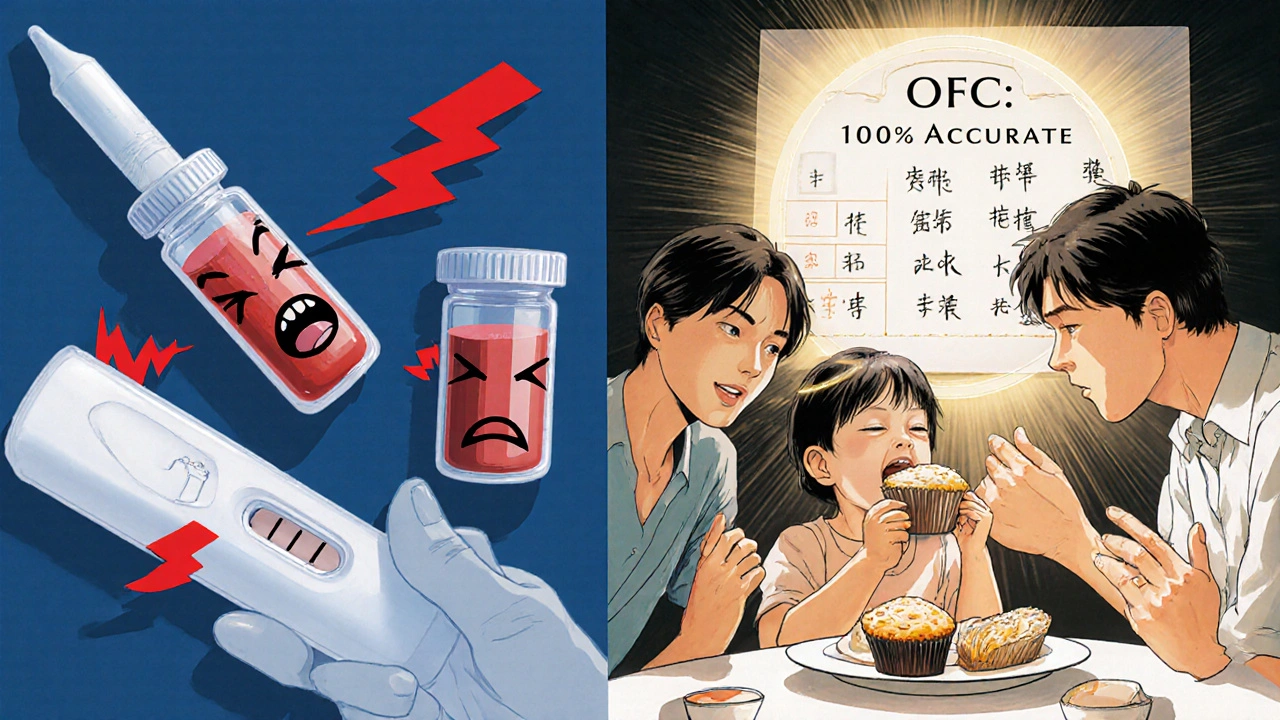When a child breaks out in hives after eating peanut butter, or an adult gets stomach cramps after drinking milk, the question isn't just what caused it-it's is it really an allergy? Many people assume a positive skin test or elevated blood marker means they’re allergic. But that’s often wrong. In fact, clinical history and lab tests alone get it right less than half the time. That’s why the real answer doesn’t come from a needle prick or a vial of blood. It comes from eating the food-slowly, safely, and under medical supervision. This is the oral food challenge (OFC), and it’s the only test that can say for sure: yes, you’re allergic-or no, you’re not.
Why Lab Tests Can’t Be Trusted Alone
Skin prick tests and blood tests for IgE antibodies are common first steps. They’re quick, non-invasive, and widely available. But they don’t tell you if you’ll actually react when you eat the food. They only show that your immune system has *recognized* the allergen before. That’s not the same as having a real allergy. For example, a child with a high IgE level to egg might test positive 90% of the time on a blood test-but only 60% of those kids will actually get sick when they eat scrambled eggs. The rest? They’re sensitized, not allergic. And that’s a huge difference. One leads to lifelong avoidance. The other means you can eat eggs without worry. The same goes for peanut. Studies show skin tests and IgE blood tests have a positive predictive value between 50% and 60% for peanut allergy. That means nearly half the time, a positive result is a false alarm. That’s why doctors don’t make diagnosis decisions based on labs alone. They need proof from real-world exposure. And that’s where the oral food challenge comes in.What Happens During an Oral Food Challenge?
An oral food challenge isn’t just eating a peanut butter sandwich and waiting to see what happens. It’s a carefully controlled medical procedure. You start with a tiny amount-sometimes just 1 to 2 milligrams of the food. That’s less than a grain of rice for peanut. Then, every 15 to 30 minutes, you get a slightly bigger dose. Each step is watched closely. Your heart rate, breathing, skin, and digestion are monitored. You might be given the food mixed into applesauce, baked into a muffin, or even in a capsule so you can’t taste it. The goal is to mimic real-life exposure while keeping you safe. The whole process takes 3 to 6 hours. Most of that time is just waiting-because reactions don’t always happen right away. Sometimes, symptoms appear an hour or more after the last dose. That’s why you stay in the clinic long after you’ve eaten the full amount. If a reaction happens, the medical team is ready. Epinephrine is on hand. Oxygen, antihistamines, steroids-all ready to go. The room is designed for emergencies, not just routine visits. About 90% of these challenges are done as “open” tests-meaning both you and the doctor know what you’re eating. That’s because it’s simpler and more practical. But in some cases, especially when anxiety might be influencing symptoms, a double-blind test is used. Neither you nor the doctor knows whether you’re getting the real food or a placebo. These are mostly used in research, not routine care.How Safe Is It?
It’s natural to be scared. The idea of eating something you think might kill you sounds terrifying. And yes, reactions do happen. But here’s the key: most are mild. About 40% to 60% of challenges result in symptoms-but the vast majority are just hives, a little flushing, or mild stomach upset. These are easy to treat with antihistamines. Severe reactions that need epinephrine? They happen in only 1% to 2% of cases when the challenge is done correctly. And that’s with trained staff watching every second. In fact, studies show that when OFCs are done in certified allergy clinics with proper protocols, the risk is lower than many everyday activities. You’re more likely to get hurt riding a bike than to have a life-threatening reaction during a food challenge. The real danger isn’t the test-it’s avoiding the test. People who skip OFCs often avoid foods they don’t need to. That leads to poor nutrition, social isolation, and anxiety that lasts for years.
Who Benefits the Most?
Oral food challenges aren’t for everyone. They’re not used as a first-line screening tool. If you’ve had a severe reaction in the past-like trouble breathing or passing out-you won’t be asked to do one right away. But they’re perfect for three situations:- When test results are unclear: You have a positive IgE test, but you’ve eaten the food before with no reaction. Is it real or not?
- When you think you’ve outgrown an allergy: Many kids outgrow milk, egg, soy, or wheat allergies by age 5. But how do you know for sure? Only an OFC can confirm it.
- When you’re being told to avoid too many foods: Some people avoid 5 or 6 foods based on vague symptoms. An OFC can cut that down to just the real culprits.
What About Home-Based Challenges?
Traditionally, OFCs were only done in hospitals or allergy clinics. But in early 2023, the American Academy of Allergy, Asthma & Immunology updated its guidelines to allow home-based challenges for low-risk patients. This is a big shift. If you’ve had a very mild reaction in the past-maybe just a few hives-and your IgE levels are low, your allergist might now recommend doing a challenge at home with a specific dosing plan. You’d get the food from your doctor, start with a tiny amount, and gradually increase over days while keeping a symptom diary. You’d still need to be in contact with your clinic and have epinephrine on hand. But this approach reduces stress, saves time, and makes testing more accessible. It’s not for everyone. High-risk patients still need clinic-based challenges. But for those who qualify, it’s a game-changer. No more taking half a day off work. No more waiting months for an appointment. Just a simple, safe process at home.
How to Prepare for an Oral Food Challenge
Getting ready for an OFC is just as important as the test itself. Here’s what you need to do:- Stop antihistamines: These can hide early symptoms. You’ll need to avoid them for 5 to 7 days before the test. That includes allergy pills, liquid antihistamines, and even some cold medicines.
- Don’t be sick: If you have a cold, asthma flare, or fever, reschedule. Your body is already stressed. Adding food exposure on top of that increases reaction risk.
- Bring distractions: Especially for kids. Bring favorite toys, books, tablets, or games. The challenge takes hours. Boredom makes anxiety worse.
- Wear comfortable clothes: You might get flushed or itchy. Loose clothing helps you feel less trapped.
- Ask questions: Know the plan. What’s the first dose? What happens if you react? Who’s in charge? The more you know, the less scary it feels.
The Bigger Picture: Why This Matters
Food allergies affect 32 million Americans. That’s one in ten kids and one in thirteen adults. And the number is rising. But we’re still over-diagnosing. Too many people avoid foods they don’t need to. That leads to nutrient gaps, especially in children. It leads to social anxiety. It leads to unnecessary stress for families. Oral food challenges fix that. They give real answers. They end the guessing. They restore freedom. And they do it safely. No blood test, no skin test, no new biomarker can match the accuracy of an OFC. Even the most advanced tests-like component-resolved diagnostics-only get about 85% right. OFC? When done right, it’s nearly 100% accurate. That’s why every major allergy society-from the American Academy of Allergy to the European Academy of Allergy and Clinical Immunology-calls it the gold standard. And it’s not going away. Experts agree: until a better test comes along, OFC will remain the only way to know for sure. New research is trying to find biomarkers that predict outcomes without eating the food. But so far, nothing comes close.Final Thoughts: The Power of a Clear Answer
One mother on a food allergy forum said it best: “The oral food challenge was terrifying but necessary. My son cried through the entire peanut challenge-but we found out he’d outgrown it. Life-changing.” That’s what this is about. Not just medicine. Not just tests. It’s about freedom. It’s about not living in fear. It’s about knowing, with absolute certainty, what’s safe and what’s not. If you’ve been told you’re allergic-but you’re not sure-you owe it to yourself to ask about an oral food challenge. Not as a last resort. Not as a gamble. As the most reliable tool you have.Are oral food challenges safe for children?
Yes, oral food challenges are safe for children when performed in a medical setting with trained staff. Mild reactions like hives or stomach upset occur in 40% to 60% of cases, but severe reactions needing epinephrine happen in only 1% to 2%. Most children tolerate the process well, especially when parents prepare them with honest, calm explanations. Clinics often use distraction techniques and disguised foods to reduce anxiety.
How long does an oral food challenge take?
An oral food challenge typically takes 3 to 6 hours. The first 1 to 2 hours involve giving small, increasing doses of the food every 15 to 30 minutes. The remaining 2 to 3 hours are for observation, since reactions can be delayed. You must stay in the clinic until the medical team confirms no reaction is developing.
Can you do an oral food challenge at home?
Yes, under specific conditions. In 2023, the American Academy of Allergy, Asthma & Immunology updated guidelines to allow home-based oral food challenges for low-risk patients. This means you’ve had only mild reactions in the past, your IgE levels are low, and you’re under close supervision. You’ll get a dosing plan from your allergist, start with tiny amounts over days, and keep a symptom diary. Epinephrine must be available at all times. Home challenges are not for high-risk cases.
What foods are commonly tested in an oral food challenge?
The most common foods tested are the top allergens: milk, egg, peanut, tree nuts, soy, wheat, fish, and shellfish. These account for over 90% of food allergies. Challenges are also done for less common allergens like sesame, mustard, or certain fruits, depending on the patient’s history. The food is usually given in its natural form-peanut butter, boiled egg, milk-or disguised in baked goods to reduce psychological triggers.
What if I have a reaction during the challenge?
If you have a reaction, the challenge stops immediately. The medical team will treat it based on severity. Mild symptoms like hives or itching are treated with antihistamines. More serious symptoms like wheezing or vomiting may require epinephrine, steroids, or oxygen. Most reactions are handled quickly and successfully in the clinic. The team will then help you understand the result and plan next steps, whether that’s continuing avoidance or safely reintroducing the food.
How accurate is an oral food challenge compared to other tests?
Oral food challenges are the most accurate test for food allergy, with near 100% diagnostic certainty when properly performed. Skin prick tests and blood IgE tests have accuracy rates between 50% and 85%, meaning they often give false positives. Component-resolved diagnostics, while more advanced, still can’t replace OFC-they’re useful for narrowing down possibilities but can’t confirm if a person will actually react when eating the food.


Franck Emma
November 22, 2025 AT 09:13This is the most terrifying thing I’ve ever heard. You’re telling me to eat peanut butter like it’s a snack? I nearly died once from a kiss from someone who ate almonds. Now you want me to volunteer for a death wish? 😭
Noah Fitzsimmons
November 23, 2025 AT 09:55Oh wow, another ‘science’ article that treats patients like lab rats. You know what’s more accurate than an OFC? Not being an idiot and avoiding foods you’re ‘sensitized’ to. Let the kids eat peanuts and then sue the hospital when they turn blue. Classic American medicine. 🤡
Eliza Oakes
November 24, 2025 AT 23:16Wait, so you’re saying we’ve been lied to for decades? That every parent who avoided eggs because of a skin test was just wasting their life? That’s not just misinformation-that’s medical malpractice. And now we’re supposed to trust a doctor who makes us eat peanut butter like it’s a dare? No thanks. I’ll keep my anxiety and my peanut-free kitchen.
Clifford Temple
November 25, 2025 AT 08:17Why are we letting foreign doctors dictate our healthcare? In America, we don’t need to eat food to know if it’s dangerous. We have laws, we have warnings, we have common sense. This ‘challenge’ nonsense is just another way for big pharma to profit off fear. Stick to the old ways-avoid, avoid, avoid.
Corra Hathaway
November 26, 2025 AT 10:23Y’all need to chill. 😊 This is actually AMAZING news! I thought my kid was allergic to milk for 4 years… turned out he wasn’t. Now he eats ice cream like a champ. 🍦 Life-changing. Stop being scared and ask your allergist about OFC. You might be surprised! #FreedomToEat
Shawn Sakura
November 26, 2025 AT 17:02I just wanted to say, this is so important. I’m a dad, and my daughter had a positive test for soy. We avoided it for 3 years. Then we did the challenge. She was fine. No more anxiety. No more separate lunches. Just… normal. Thank you for explaining this so clearly. I wish every parent knew this. 🙏
Paula Jane Butterfield
November 27, 2025 AT 07:32As someone who grew up in a household where food allergies were treated like curses, this article feels like a gift. I remember my mom crying because I couldn’t eat birthday cake. Now I’m a nurse, and I’ve seen how OFCs change lives. Please, if you’re unsure-ask. Don’t let fear rob you of joy. You deserve to eat without guilt. 🌱
Simone Wood
November 28, 2025 AT 12:45Oral food challenges are a dangerous placebo-driven farce. The IgE response is a biomarker of immune memory-not clinical reactivity. The diagnostic specificity is compromised by confounding variables like mast cell activation syndrome, cross-reactivity with pollen allergens, and non-IgE-mediated inflammation. You’re essentially performing a controlled provocation without validating underlying pathophysiology. This is not medicine-it’s performative risk-taking dressed as science.
Swati Jain
November 29, 2025 AT 22:21OMG, this is why I left the US healthcare system. In India, we don’t need to eat peanut butter to know if it’s bad for you. If your face swells, you’re allergic. Simple. No 6-hour hospital drama. No $2000 bills. Just… don’t eat it. And if you do? Well, that’s your funeral. 😅
Florian Moser
November 29, 2025 AT 23:01For anyone considering an OFC: prepare mentally, not just physically. The anxiety is real-but so is the relief. I did one for egg last year. I cried when I ate the first full serving. Not from fear-from freedom. This isn’t just a test. It’s a rebirth. Talk to your allergist. Don’t wait. You’ve got this.
jim cerqua
December 1, 2025 AT 05:08Let me guess-the next thing they’ll say is ‘just eat your way out of autism.’ First they tell us to avoid food, then they tell us to eat it like it’s a game show. Who’s making the money here? The clinic? The food manufacturers? The insurance companies? Someone’s cashing in on our kids’ fear. And we’re all just playing along. 🎭
Donald Frantz
December 2, 2025 AT 10:33Interesting data, but I’m curious: what’s the long-term follow-up on these patients? Do those who pass the challenge maintain tolerance over 5–10 years? Or do they develop new sensitivities later? And how does this interact with gut microbiome changes? I’d like to see peer-reviewed longitudinal studies before I fully endorse this as standard care.
Sammy Williams
December 3, 2025 AT 22:20My sister did this for peanut and it was wild. She was shaking the whole time. But when they gave her the last bite and nothing happened? She screamed. We all cried. Now she eats trail mix like a boss. Best decision she ever made.
Julia Strothers
December 4, 2025 AT 10:33They’re lying. This is a cover-up. The FDA, AMA, and Big Pharma don’t want you to know that food allergies are caused by GMOs, glyphosate, and vaccine adjuvants. The ‘challenge’ is just a distraction. They want you to eat the poison so they can say ‘see? It’s fine!’ while they profit from epinephrine pens and gluten-free snacks. Wake up.